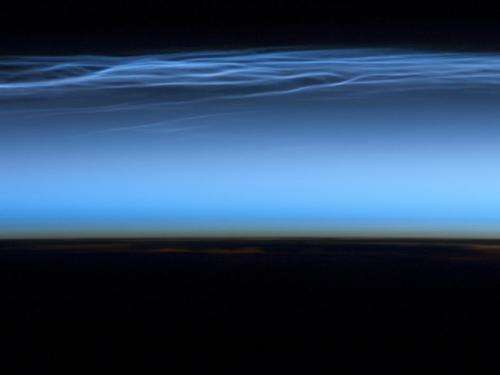Image: Station crew sees 'night-shining' clouds

(Phys.org) -- In both the Earth's Northern and Southern Hemispheres polar mesospheric clouds are at the peak of their visibility, during their respective late spring and early summer seasons. Visible from aircraft in flight, the International Space Station and from the ground at twilight, the clouds typically appear as delicate, shining threads against the darkness of space--hence their other names of noctilucent or "night-shining" clouds.
On June 13, 2012, when this image was taken from the space station as it passed over the Tibetan Plateau, polar mesospheric clouds were also visible to aircraft flying over Canada. In addition to the still image above, the station crew took a time-lapse image sequence of polar mesospheric clouds several days earlier on June 5, while passing over western Asia. It is first such sequence of images of the phenomena taken from orbit.
Polar mesospheric clouds form between 47 to 53 miles (76 to 85 kilometers) above Earth’s surface when there is sufficient water vapor at these high altitudes to freeze into ice crystals. The clouds are illuminated by the sun when it is just below the visible horizon, lending them their night-shining properties. In addition to the polar mesospheric clouds trending across the center of the image, lower layers of the atmosphere are also illuminated. The lowest layer of the atmosphere visible in this image--the stratosphere--is indicated by dim orange and red tones near the horizon.
Provided by NASA




















